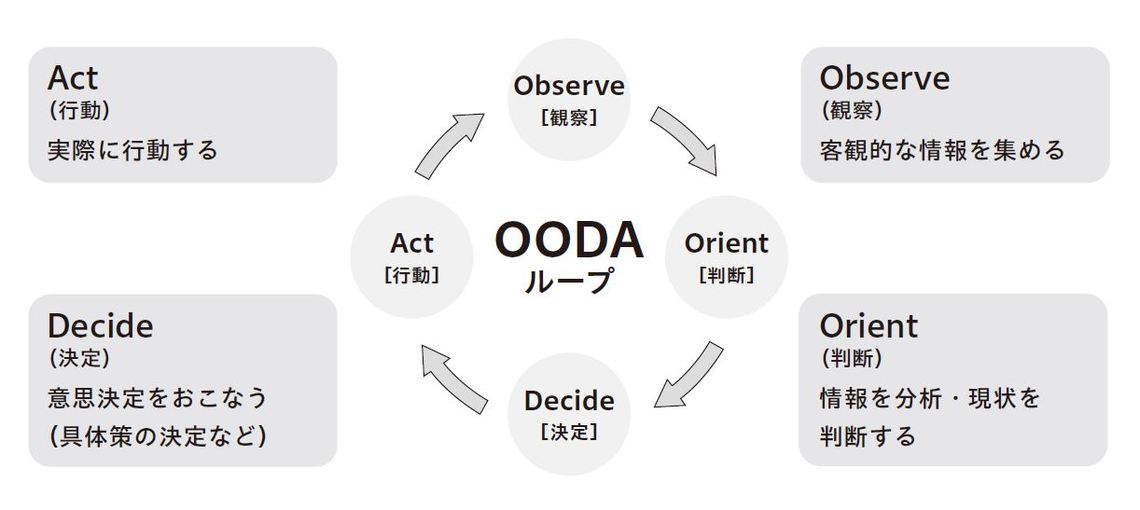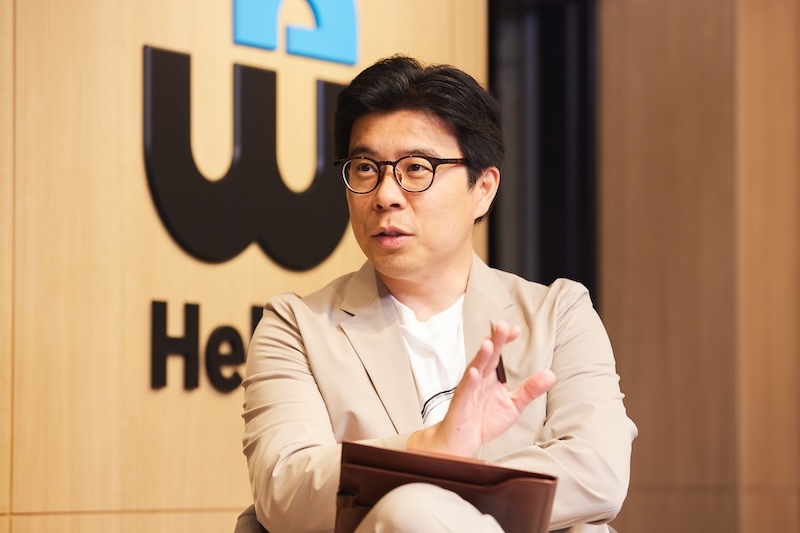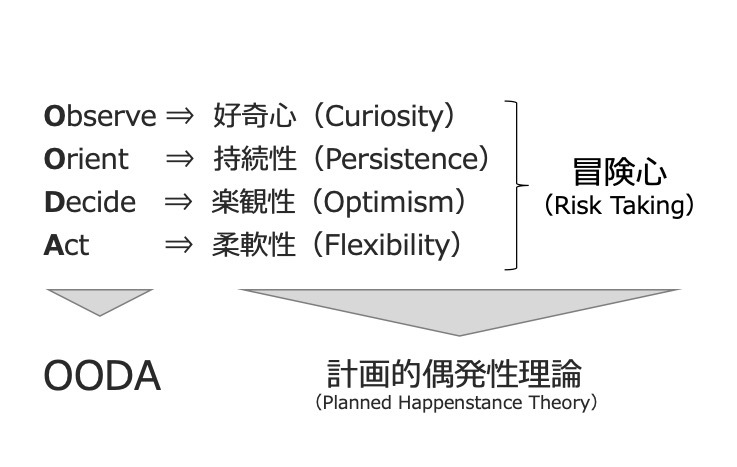OODA, a decision-making model gaining attention for solving rapidly changing modern business challenges, proves effective not only in organizational development and management strategy but also in branding and marketing.
This series explores the appeal of OODA from multiple angles. Our guest this time is non-no exclusive model Kazune Sato. Her diverse career as a model and variety show personality reveals insights for navigating the future: adaptability to change, flexibility, and an adventurous spirit unafraid to take risks.
Aaron Zou, author of "OODA Loop Leadership: The World's Most Powerful Doctrine" (Shuwa Systems), provides insights.
【What is OODA?】

A decision-making and action process proposed by John Boyd, a former U.S. Air Force Colonel and fighter pilot. The term OODA is an acronym for Observe, Orient, Decide, Act. Its purpose is to consistently take the best course of action in constantly changing, unpredictable situations. In Western business and marketing, OODA is recognized as an essential decision-making process alongside the traditional PDCA cycle. ( Learn more here ).
Winning Auditions with "Passion" and "Talking Skills"
Aaron: Kazune-san, you won the Photogenic Award at the "Watanabe Next Generation Audition 2023" and were selected as the youngest exclusive model for non-no at age 18. Now, you're active not only as a model but also appearing on variety shows and more. When did you first start aiming for a career in the entertainment industry?
Sato Kazune (hereafter Sato): I'm from Osaka. I'd been doing cheer dance since first grade, and in fifth grade, I went to Tokyo to compete in the national championships. That's when I was scouted by talent agency scouts on Takeshita Street, which made me start thinking about the entertainment industry. I especially loved reading magazines, so I vaguely thought, "It would be nice to become a model someday."
After that, I focused solely on cheer until I graduated junior high. But when I quit cheer upon entering high school, I suddenly had nothing else to pour myself into. That's when I decided to seriously pursue modeling, something I'd always admired. I researched various agencies myself and ended up joining the Watanabe Entertainment school.
Aaron: I see. Did you attend the Osaka school?
Sato: No, the Tokyo branch. I could have chosen the Osaka branch, but I thought if I was going to do this, I wanted to challenge myself in Tokyo. I'd take the overnight bus to Tokyo on Saturday night, take lessons all day Sunday, then take the overnight bus back to Osaka. On Monday morning, I'd take a bath at my grandmother's house nearby and go straight to school. I kept up that lifestyle.
Aaron: That's amazing. Wasn't it tough?
Sato: During the latter half of high school, I had lessons every week, so physically it was tough. But it was incredibly fulfilling and fun.
Aaron: Did your parents support you aiming for the entertainment industry?
Sato: They told me, "That's impossible," at first because it's not an easy world. But once I decided to do it, they said, "If you're going to do it, do it seriously. If you aim for the top, then go for it." Those words supported me, helping me push through the lessons. When I participated in the "Watanabe Next Generation Audition," I approached it with the mindset that I absolutely had to pass.
Aaron: That's wonderful. Winning the Photogenic Award at the "Watanabe Next Generation Audition" and then being selected as an exclusive model for non-no must have been a major turning point. What did you do specifically to prepare for passing the audition?
Sato: First, there was a document screening. If you passed that, you advanced to the audition. But the audition date conflicted with my high school graduation ceremony. I realized this was a life-changing moment, so I skipped graduation to take the audition.
Aaron: I see, you saw it as a decisive moment in your life.
Sato: Yes. I thought, "I can't possibly get rejected in the interview after skipping graduation just for this audition," so I poured out my passionate feelings for non-no (laughs). During the camera test, I knew I had less posing experience than the other girls, so I kept talking nonstop throughout the shoot, passionately expressing my thoughts. I think that helped convey my personality better.
Aaron: Wow, you calmly assessed your position and created a competitive edge by maximizing your strengths—your "passion" and "talking skills." How did you feel when you passed the audition?
Sato: One day, my manager told me, "There's an issue with the contract documents, so bring your seal." When I went to the agency, they surprised me with the acceptance announcement. I just burst into tears. Tears were streaming down like a waterfall (laughs).
While being an exclusive non-no model, she also actively takes on variety shows
Aaron: Since debuting as a new non-no model at "Rakuten GirlsAward 2024 SPRING/SUMMER," you've been active across magazines and web platforms. What challenges are you currently facing?
Sato: I blink way too much. The other girls have lots of modeling and gravure experience, so they're really good at timing their blinks. But when we shoot together, I'm often the only one "messing up." Right now, I'm desperately practicing my blinking.
Aaron: non-no has over a dozen exclusive models. What do you consciously do to express your unique self among them?
Sato: I'm still figuring things out, but I try to talk a lot during breaks between shoots. That way, I can stay my usual self, and I think it helps me bring out my true personality when we start shooting again.
Aaron: So "talking" really is what defines Kazune. Beyond non-no, there are many people categorized as "models." What kind of position are you aiming for within that field?
Sato: I've always been really interested in variety shows. Thanks to that, I'm gradually getting more variety work, so right now I want to be a model who can shine in variety shows.
Aaron: I see. It's true that young models who can really hold their own in variety shows are quite rare. I don't think you consciously set out to do this, but it's interesting how you naturally sense a blue ocean (a market with less competition) and act on it. Plus, combining non-no, a top-tier brand in the modeling industry, with variety shows where you can showcase your unique "talking" ability is brilliant.
Sato: Oh, no, no—I'm still just starting out, and there are senior models who are already successful in variety shows, so it feels a bit daunting. But I want to study more and build up my skills.
Aaron: That positive, challenging attitude is wonderful. Do you ever feel anxious?
Sato: Well, of course, I sometimes worry if I'm doing okay as I am, but I think everyone feels that way. At least right now, I feel like I'm moving forward, so I try not to overthink it and just give my all to each task right in front of me.
Analyzing Kazune Sato's Mindset Through the Theory of Planned Serendipity
Aaron: Hearing you speak so far, I feel Kazune's mindset holds many hints for navigating the future. While we could analyze this through an OODA lens, this time I'd like to explain it using the "Planned Happenstance Theory" – a theory often cited as sharing common ground with OODA – which is valuable for understanding career formation.
Planned Happenstance Theory, simply put, suggests that an individual's career path is determined to some extent by chance. Essentially, it's the idea that setting overly detailed future goals or plans can actually lead to missed opportunities. Instead, you set a broad direction, place yourself in an environment where opportunities are likely to arise, and engage with things (the "planned" part), then seize chances that come from chance encounters or unexpected events (the "happenstance" part).
Sato: Ah, that definitely applies to me.
Aaron: Exactly. Kazune-san had a broad direction in mind—modeling and the entertainment industry—but I don't think you aimed for non-no from the start. You placed yourself in an environment ripe with "chance," like Watanabe Entertainment's Tokyo school, and kept working hard. That's how you encountered the opportunity of an audition and seized it.
Sato: That's right. Back then, I never imagined I'd become an exclusive model for non-no.
Aaron: However, to effectively apply planned happenstance theory, you must constantly be mindful of five key elements: "Curiosity," "Persistence," "Optimism," "Flexibility," and "Risk Taking." These elements help bring you closer to the career path you envision.
Sato: Hmm...
Aaron: And now, this is my personal view, but I believe "Risk Taking," one of these five elements, is common to the other four. In other words, "Curiosity," "Persistence," "Optimism," and "Flexibility" correspond to each phase of the OODA loop. These five elements align with Kazune-san's mindset and actions.
Sato: I see...
Aaron: Choosing an agency that aligns with your vision after researching various options, or observing your surroundings to identify your strengths—these actions fundamentally require "Curiosity" as a prerequisite. Next, as seen in cheer dance, there's "Persistence" – the ability to keep attending a Tokyo school if deemed necessary; "Optimism" – making decisions positively without overthinking; "Flexibility" – acting on decisions adapted to the situation without clinging to a single idea. And of course, her "Adventurous Spirit" is evident in choices like skipping graduation to attend an audition.
These elements share common ground with OODA – "Observe," "Orient," "Decide," "Act" – and represent a mindset essential for navigating the rapidly changing times ahead. I believe this is precisely why Kazune-san achieved such a significant milestone as becoming a non-no exclusive model and continues to thrive.
Sato: That makes me incredibly happy. I never thought I had any particular talent. I've always struggled with schoolwork, and even as a vice-captain on the cheerleading squad, I sometimes didn't make the final selections. But what I have consistently done is keep putting in the effort—studying at school from morning till late at night every day, and diligently practicing cheerleading day after day. Knowing that my past actions, that persistence, have led me to where I am now—having that acknowledged makes me feel it was all worth it.
Aaron: Exactly. Kazune-san's strong determination might be what draws good fortune to you. Even if you don't see results right away, your efforts can unexpectedly connect to what you're working on now. In that sense, I think it's important to have a big vision, but not over-plan the details. Keep an adventurous spirit and challenge yourself with what's right in front of you.
Sato: That's right. Somehow, that makes me feel really positive!
Aaron: I'm glad. I sincerely look forward to seeing Kazune-san achieve even greater success in the future!















